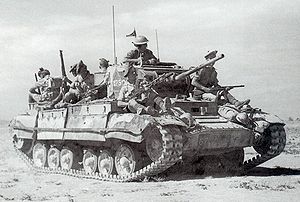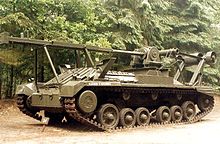Valentine (tank)
| Valentine, Mk I-XI | |
|---|---|

Valentine III in North Africa with mounted Scottish infantry |
|
| General properties | |
| crew | 4 (commander, gunner, loader, driver) |
| length | 5.40 m |
| width | 2.60 m |
| height | 2.20 m |
| Dimensions | 16-17 tons |
| Armor and armament | |
| Armor | 8-65 mm |
| Main armament | 1 × 40mm cannon ( Ordnance QF 2-pounder ) |
| Secondary armament | 1 × 7.92mm Besa machine gun |
| agility | |
| drive | GMC 131-210 PS |
| Top speed | 24 km / h |
| Power / weight | 8.1 hp / ton |
| Range | 145 km |
The Valentine, or Tank, Infantry Mk III was a British infantry tank from World War II and the result of a private development by Vickers-Armstrongs who, in early 1938, presented their vehicle to the Minister for the Coordination of Defense, just before Valentine's Day (February 14th) and that is why was given the name "Valentine". The tank was built in eleven variants by three companies in several thousand copies. Vehicles were also manufactured under license in Canada by the Canadian Pacific Railway Company.
history
Since the war development left no time for pre-production models, the tank was ordered and produced off the drawing board, so to speak. Except for the cooling and the track drive, the original design turned out to be reliable and promising. The deficiencies were subsequently corrected. In July 1939 Vickers-Armstrongs received the order for 275 tanks, another 125 from the Metropolitan-Cammell Carriage & Wagon Co. Ltd. (MCCW - Metro Cammell) supplied, 200 by the Birmingham Railway Carriage & Wagon Co. Ltd.
In the early summer of 1940, 1,325 Valentines had already been commissioned and a further 600 were ordered - an additional 300 in cooperation with Canada. In mid-1941, 45 vehicles rolled out of the factory every month, gradually replacing the older Matilda II .
A 6-cylinder diesel engine was installed in the Valentine II ( Mark III infantry tank ) instead of the petrol engine from the Valentine I series . All versions of the early war years were armed with a 2 pounder 40 mm cannon and a 7.92 mm machine gun. Subsequent variants were especially equipped with a larger turret and a stronger main armament. As with all British tanks of the Second World War, the commander had a Vickers 360 ° angle mirror MK.IV to observe the battlefield under armor protection.
The Valentine was first used on a large scale during Operation Crusader in November 1941 in North Africa . Its advantages over the Matilda II were the slightly better mobility and the high mechanical reliability. The main armament, which remained unchanged, proved to be a major disadvantage. Later models were upgraded with a 6-pounder cannon caliber 57 mm, but this was only possible without a member of the tower crew. In order to improve the firepower of the armored units, the Archer tank destroyer and the Bishop self-propelled gun were built on the chassis of the Valentine in 1943 . With the availability of the better armed Churchill and Sherman , the Valentine was replaced by these and practically only used as a training vehicle.
The Valentine had the largest proportion of tanks delivered to the Soviet Union: 1,388 Canadian and 2,394 British vehicles were delivered there. This was almost all Canadian and 29% British production. Production continued in support of the Soviet Union until 1944. There the Valentine was valued for its reliability, good armor and small size.
Valentine captured from the German side were used under the designation PzKw Mk. III 749 (e).
Technical specifications
Valentine II
- Length: 5.40 m
- Width: 2.60 m
- Height: 2.20 m
- Drive: Diesel engine with 131 HP (later models up to 210 HP)
- Speed: 24 km / h (road)
- Armor: max. 65 mm
- Armament: 40 mm cannon, 7.92 mm coaxial machine gun
- Crew: 4 men
Special version: Valentine MK II bridge-laying tank
- Top speed: 24 km / h
- Crew: 1 man
- no armament
literature
- Dick Taylor: Into the Vally. The Valentine Tank and Derivatives 1938-1960. Mushroom Models, 2011, ISBN 978-83-61421-36-8 .
Web links
Individual evidence
- ^ Benjamin Coombs: British Tank Production and the War Economy, 1934-1945. Bloomsbury Academic, 2015, ISBN 978-1-4742-2790-2 , p. 11.


